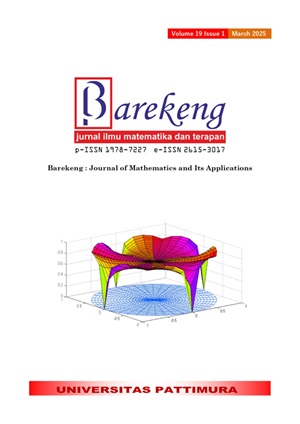THE COMPARISON OF ARIMA AND RNN FOR FORECASTING GOLD FUTURES CLOSING PRICES
Abstract
In the financial markets, accurately forecasting the closing prices of gold futures is crucial for investors and analysts. Traditional methods like ARIMA (Autoregressive Integrated Moving Average) have been widely used for this purpose, particularly for their effectiveness in short-term stable data forecasting. However, the inherent complexity and dynamic nature of financial data, coupled with trends and seasonal patterns, present significant challenges for long-term forecasting with ARIMA. Conversely, advanced methods such as Recurrent Neural Networks (RNN) have shown promise in handling these complexities and providing reliable long-term forecasts. This research seeks to evaluate and compare the performance of ARIMA and RNN in forecasting daily gold futures closing prices using forecast accuracy tests namely RMSE and MAPE, aiming to identify the optimal method that balances accuracy, stability, and adaptability to trends and seasonal variations in the financial market. The daily data for this analysis is sourced from Investing.com (https://www.investing.com).
Downloads
References
E. H. A. Rady, H. Fawzy, and A. M. A. Fattah, “Time series forecasting using tree based methods,” J Stat Appl Probab, vol. 10, no. 1, pp. 229–244, 2021, doi: 10.18576/JSAP/100121.
G. Shmueli and P. Julia, Practical Time Series Forecasting With R, Third edit. Axelrod schnall publisher, 2024.
Robert H. Shumway and David S. Stoffer, Time Series Analysis and Its Applications With R Examples, Third edition. london: Springer, 2010. [Online]. Available: www.springer.com/series/417
D. Fan, H. Sun, J. Yao, K. Zhang, X. Yan, and Z. Sun, “Well production forecasting based on ARIMA-LSTM model considering manual operations,” Energy, vol. 220, Apr. 2021, doi: 10.1016/j.energy.2020.119708.
M. A. Gustiansyah et al., “Aplikasi Model ARIMA dalam Peramalan Data Harga Emas Dunia Tahun 2010-2022,” Jurnal Statistika dan Aplikasinya, vol. 7, no. 1, pp. 84–92, 2023, doi: 10.21009/jsa.07108.
T. Wahyuni, I. Indahwati, and K. Sadik, “Perbandingan Arima Dan Artificial Neural Networks Dalam Peramalan Jumlah Positif Covid-19 di DKI Jakarta,” Xplore: Journal of Statistics, vol. 10, no. 3, pp. 288–301, Sep. 2021, doi: 10.29244/xplore.v10i3.846.
T. Chakraborty, S. Chattopadhyay, and I. Ghosh, “Forecasting dengue epidemics using a hybrid methodology,” Physica A: Statistical Mechanics and its Applications, vol. 527, Aug. 2019, doi: 10.1016/j.physa.2019.121266.
D. Tarkus, S. R. U. A. Sompie, and A. Jacobus, “Implementasi Metode Recurrent Neural Network pada Pengklasifikasian Kualitas Telur Puyuh,” Jurnal Teknik Informatika, vol. 15, no. 2, pp. 137–144, 2020.
G. V. Datla, H. Jiang, and J. T. L. Wang, “An Interpretable LSTM Network for Solar Flare Prediction,” in International Conference on Tools with Artificial Intelligence, ICTAI, IEEE Computer Society, 2023, pp. 526–531. doi: 10.1109/ICTAI59109.2023.00084.
Md. R. Karim et al., “Interpreting Black-box Machine Learning Models for High Dimensional Datasets,” pp. 1–16, Aug. 2022, [Online]. Available: http://arxiv.org/abs/2208.13405
R. Madan and P. S. Mangipudi, “Predicting Computer Network Traffic: A Time Series Forecasting Approach using DWT, ARIMA and RNN,” Eleventh International Conference on Contemporary Computing (IC3), pp. 2–4, Aug. 2018.
Imelia Santoso, “ni 6 Perbedaan Mencolok Spot Emas dan Emas Berjangka,” blog.hsb.co.id, Sep. 10, 2019. Accessed: May 10, 2024. [Online]. Available: https://blog.hsb.co.id/pengetahuan-keuangan/perbedaan-spot-emas-dan-emas-berjangka/
D. Rakhmawati and M. Nurhalim, “Prediksi harga emas berjangka di masa pandemi covid-19 menggunakan model tren deterministik,” AKUNTABEL, vol. 18, no. 1, pp. 146–152, 2021, [Online]. Available: http://journal.feb.unmul.ac.id/index.php/AKUNTABEL
A. Santoso, A. I. Purnamasari, and I. Ali, “Prediksi Harga Beras Menggunakan Metode Recurrent Neural Network Dan Long Short-Term Memory,” Jurnal PROSISKO, vol. 11, no. 1, pp. 128–136, 2024.
J. Soeryawinata, H. Novianus, and L. W. Santoso, “Sales Forecasting pada Dealer Motor X Dengan LSTM, ARIMA dan Holt-Winters Exponential Smoothing,” vol. 10, no. 2, pp. 1–4, 2022.
S. Makridakis, D. Wirajaya, and S. C. Wheelwright, Metode-metode peramalan untuk manajemen, 5th ed. Jakarta: Binarupa Aksara, 1989.
D. Yulianti, I. Made Sumertajaya, and I. D. Sulvianti, “Pemodelan Harga Beras di Pulau Sumatera dengan Menggunakan Model Generalized Space Time ARIMA,” Xplore, vol. 2, no. 2, pp. 49–57, 2018.
M. Ridwan, K. Sadik, and M. Afendi, “Comparison of ARIMA and GRU Models for High-Frequency Time Series Forecasting,” Scientific Journal of Informatics, vol. 10, no. 3, p. 389, 2023, doi: 10.15294/sji.v10i3.45965.
D. C. Montgomery, C. L. Jennings, and M. Kulahci, “Wiley Series in Probability and Statistics,” 2015.
C. Yin, Y. Zhu, J. Fei, and X. He, “A Deep Learning Approach for Intrusion Detection Using Recurrent Neural Networks,” IEEE Access, vol. 5, pp. 21954–21961, Oct. 2017, doi: 10.1109/ACCESS.2017.2762418.
C. Tian, J. Ma, C. Zhang, and P. Zhan, “A deep neural network model for short-term load forecast based on long short-term memory network and convolutional neural network,” Energies (Basel), vol. 11, no. 12, Dec. 2018, doi: 10.3390/en11123493.
Copyright (c) 2025 Windy Ayu Pratiwi, Anwar Fajar Rizki, Khairil Anwar Notodiputro, Yenni Angraini, Laily Nissa Atul Mualifah

This work is licensed under a Creative Commons Attribution-ShareAlike 4.0 International License.
Authors who publish with this Journal agree to the following terms:
- Author retain copyright and grant the journal right of first publication with the work simultaneously licensed under a creative commons attribution license that allow others to share the work within an acknowledgement of the work’s authorship and initial publication of this journal.
- Authors are able to enter into separate, additional contractual arrangement for the non-exclusive distribution of the journal’s published version of the work (e.g. acknowledgement of its initial publication in this journal).
- Authors are permitted and encouraged to post their work online (e.g. in institutional repositories or on their websites) prior to and during the submission process, as it can lead to productive exchanges, as well as earlier and greater citation of published works.






1.gif)



